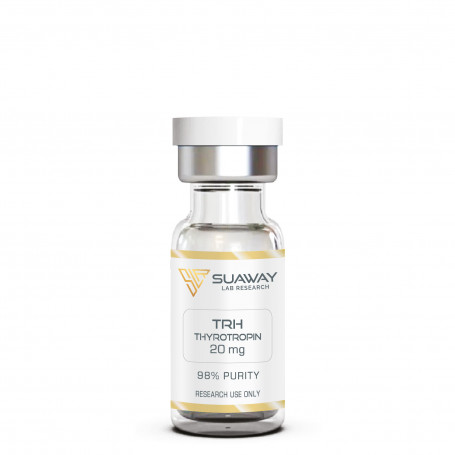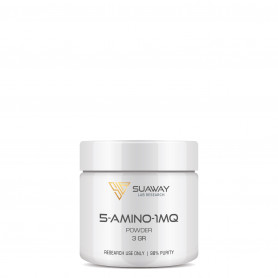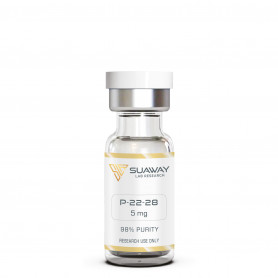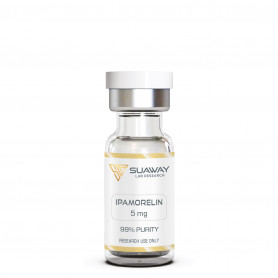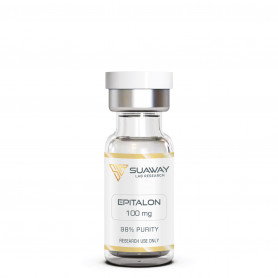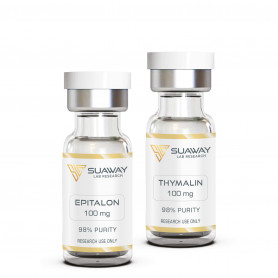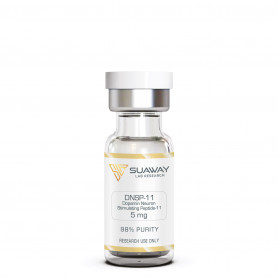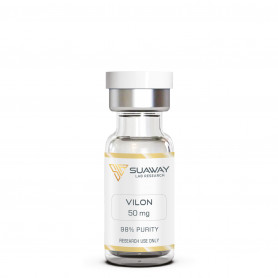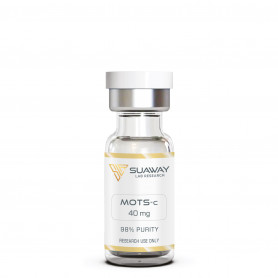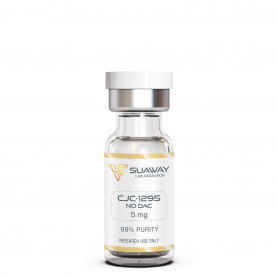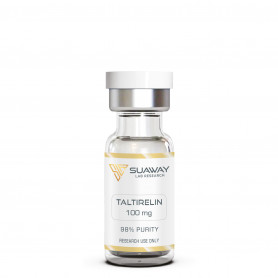TRH - THYROTROPIN - 20 mg
TRH (thyrotropin releasing hormone) is a small peptide hormone produced in the hypothalamus. Research on TRH has shown improvement in thyroid function as well as multiple other effects:
- Antidepressant activity
- Aging-Reversing
- Free radical reduction
- Regulation of the autonomic nervous system
- Loss of fat deposits
- Lowering of sugar and triglyceride levels
Description
STRUCTURE
Sequence: (pyro)Glu-His-Pro-NH2
Molecular Formula: C16H22N6O4
Molecular Weight: 362.38367 g/mol
CAS: 24305-27-9
Peptide purity: Greater than 98%
Other details: No TFA Salt
Storage: Lyophilized peptide must be stored at -20°C and peptide solution at 4°C.
TRH has good oral and excellent subcutaneous bioavailability.
DESCRIPTION
Considerable evidence supports a pivotal role for TRH in the pathophysiology of the inflammatory process with specific relevance to the “cytokine-induced sickness behavior” paradigm. These findings, combined with a number of documented clinical actions of TRH strongly support a potential utility of TRH-based therapeutics in select inflammatory disorders.
In vitro and in vivo evidence suggests a critical role for TRH during the developmental stages of the immune system as well as its numerous interactions with the fully developed immune system.
Recent advances in the field of immunology provide a significant opportunity for investigation of the TRH-immune system homeostatic hypothesis. Moreover, this hypothesis may provide a foundation for the development of TRH-based therapeutics for certain medical and psychiatric disorders involving immune dysfunction.
Ader first used the term “psychoneuroimmunology” in 1980 (Ader, 1980) to describe the increasing body of evidence about interactions between the brain and the immune system. Since then research has demonstrated significant involvement of the endocrine system in brain-immune interactions in both health and disease states. These multi-directional interactions can occur at many stages of development, and they are a continual part of the drive to maintain homeostasis. Defects or deficiencies in one or more of these systems can lead to a specific disorder or aggravate a variety of other disorders.
Interactions between the central nervous system (CNS), the endocrine system and the immune system are mediated at multiple levels. These mediators include secreted chemical messengers such as hormones, cytokines, neurotransmitters and neuropeptides acting directly or via the nervous system. Evidence indicates interactions at the level of receptors (e.g., the presence of neuroendocrine peptide receptors on immune cells), at the level of secretory function (e.g., the synthesis and secretion of neuroendocrine peptides by immune cells), and at the level of signal transduction.
In addition to its classical function as a hypothalamic hypophysiotrophic factor, the widespread distribution of TRH and its receptors suggests that the tripeptide plays important roles in other systems. TRH has been identified throughout the CNS, including retina and spinal cord. TRH immunoreactivity has been detected in several peripheral tissues. Polymerase chain reaction (PCR) amplification analyses detected the expression of TRH in testes, adrenal.
The delineation of two paradigms pertaining to interactions between the CNS, the immune system and the endocrine system has significantly advanced the field of psychoimmunology. One of these paradigms pertains to interactions between these systems in the LPS-induced sickness response. The second paradigm involves interactions between these systems to control gastric function and control of other visceral organs.
Thyrotropin-releasing hormone (TRH) aroused the interest of researchers when they were engaged in related experiments. So they decided to study its effects on organs, tissues, and aging-related metabolic and hormonal markers when administered in acute or chronic (oral) doses at various time points in its cyclic circadian pattern. They also wanted to determine what effects, if any, it had on aging processes in two essential systems, namely gonadal-reproductive and kidney-urinary. The results show positive changes as a result of short-term acute and long-term chronic oral administration of TRH to old mice that included rapid correction to more juvenile levels of most typical aging-related hormonal and metabolic measurements.
Remarkably, testes function was maintained by means of a 4-month oral treatment with TRH in aging mice.
As the researchers upon seeing a significant increase in testes weight, TRH resulted in maintenance or even reconstitution of testes structure and function when administered in the drinking water.
This was demonstrated by the active formation and proliferation of mature spermatogonia and the intensive spermatogenesis in the follicles. The same TRH treatment led to protection for the kidneys from amyloid and hyalin infiltration of tubuli and glomeruli, which typically occurs in aging mice.
In fact, the researchers observed massive deposits of amyloid and hyalin material infiltrating the shrunken glomeruli and negatively affecting filtration capacity of the untreated mice, whereas this was barely present in the TRH-treated mice.
Advanced hyalin degeneration could also be observed in the tubular vessels of the untreated control mice. These experiments with TRH supplementation show clear aging-delaying and apparently even aging-reversing effects of the neuropeptide, whether it was administered parenterally or orally. TRH, like melatonin, is an anti-aging agent with a broad spectrum of activities that, because of their actions, suggest that TRH has a fundamental role in the regulation of metabolic and hormonal functions.
These experiments with parenteral and oral administration of TRH show a most remarkable aging-delaying and apparently even aging-reversing effects of the neuropeptide TRH. Again, similarly to melatonin, we are confronted with an anti-aging agent with a broad spectrum of activities which must be necessarily linked to a most fundamental role in the regulation of metabolic and hormonal functions.
In man, THR is concentrated in certain areas of the anterior hypothalamus and the pineal gland in the brain, and in the insulin-producing beta cells in the pancreas. Even at very high concentration and injected by the intravenous route, no side-effects whatsoever or noxious effects have ever been observed. Since its discovery in the 50s by the Nobel Prize Roger Guillemin, hundreds of publications have documented an amazing number of positive effects. However, its short half-life has prevented its extensive clinical use, since TRH is rapidly destroyed in the stomach and in the gut. Therefore Sub Cutaneous administration has been shown to be advantageous.
In the years 1989-1990, Dr. Walter Pierpaoli published his first relevant paper describing the amazing variety of effects of TRH in the reconstitution of the thymus - the master gland for the immune system which naturally declines during aging, and its anti-viral effects against a lethal virus. However, all the effects of TRH are not simply produced by an increase of thyroid hormones. Later on additional publications have illustrated TRH and it's anti-aging effects.
Recently, Dr. Pierpaoli has demonstrated with different obesity models in mice how TRH is able to reverse and abrogate aging related adiposity and correct aging-related hormonal alterations by acting directly on the hormones regulating fat stores. He has also observed that TRH produces a rapid mobilization of triglycerides in the blood, a decrease of leptin and consequently a rapid loss of body weight. Dr. Pierpaoli has suggested that TRH may constitute a key element in the hormone-controlled regulation of body weight and fat stores. This mechanism is fundamental for the maintenance of body weight, whose control is progressively weakened with age.
At the 5th Stromboli Conference on Aging and Cancer in June 2010, Dr. Pierpaoli illustrated the amazing variety of aging-reversing activities of TRH with clear-cut evidence at various levels. Besides observing a correction to juvenile levels of all parameters measured, Dr. Pierpaoli was able to produce a total correction of two typical aging-related degenerative processes, namely a reversal of testis atrophy with restoration of spermatozoa production and maturation, and a total recovery of kidney function with maintenance of glomerular filtration and tubular function, as shown by disappearance of hyalin and amyloid infiltration which are typical of kidney degeneration during aging.
In order to verify the aging-reversing affects of TRH, he suggests the measurement of some simple blood parameters such as glycemia and triglycerides before use.
Moreover, Dr. Pierpaoli's research suggests that TRH is a master hormone responsible not just for helping to adjust thyroid hormones (its principle recognised role), but in helping to recorrect many imbalances throughout the body. For example in his animal experiments TRH supplements have encouraged old animals to:
- Re-establish spermatogenesis, (reversing the age-related dysfunction of their testes)
- Correct kidney dysfunction, (a significant finding for renal issues)
- Correct pancreatic dysfunction, (a significant finding for diabetic issues)
- Act as an anti-cancer/protective agent
- Lose significant fat deposits and hence weight within 2 to 3 months.
Research has shown that after one month of daily use, both blood sugar levels and Triglyceride levels were significantly lower. The loss of body fat will follow in the course of the treatment but, a few months are necessary to observe how the new metabolic and juvenile pathways will result in aging reversal and visceral fat reduction.
REFERENCES
M. Yoneda et al., "Protective effect of central thyrotropin-releasing hormone analog on cerulein-induced acute pancreatitis in rats" [ScienceDirect]
J.C. Garbutt et al., "Dose-response studies with protirelin" [PubMed]
M.B. Stein et al., "Thyrotropin and prolactin responses to protirelin (TRH) prior to and during chronic imipramine treatment in patients with panic disorder" [PubMed]
G.G. Yarbrough et al., "Thyrotropin-releasing hormone (TRH) in the neuroaxis: Therapeutic effects reflect physiological functions and molecular actions" [ScienceDirect]
L. Luo et al., "Thyrotropin releasing hormone (TRH) in the hippocampus of Alzheimer patients" [PubMed]
E. Gaspar et al., "Thyrotropin releasing hormone (TRH): a new player in human hair-growth control" [PubMed]
W. Pierpaoli "Aging-reversing properties of thyrotropin-releasing hormone" [PubMed]
W. Pierpaoli et al., "Effects of long-term intraperitoneal injection of thyrotropin-releasing hormone (TRH) on aging- and obesity-related changes in body weight, lipid metabolism, and thyroid functions" [PubMed]
W. Pierpaoli "The involvement of pineal gland and melatonin in immunity and aging. I. Thymus-mediated, immunoreconstituting and antiviral activity of thyrotropin-releasing hormone" [PubMed]
V.A. Lesnikov et al., "The involvement of pineal gland and melatonin in immunity and aging: II. Thyrotropin-releasing hormone and melatonin forestall involution and promote reconstitution of the thymus in anterior hypothalamic area (AHA)-lesioned mice" [PubMed]
J.L. Charli et al., "The Thyrotropin-Releasing Hormone-Degrading Ectoenzyme, a Therapeutic Target?" [PMC]
S. Raiden et al., "TRH receptor on immune cells:In vitro andin Vivo stimulation of human lymphocyte and rat splenocyte DNA synthesis by TRH" [Journal of Clinical Immunology]
V. Štrbák et al., "Pancreatic Thyrotropin Releasing Hormone and Mechanism of Insulin Secretion" [Cellular Physiology and Biochemistry]
H. Heuer et al., "Thyrotropin-releasing hormone (TRH), a signal peptide of the central nervous system" [PubMed]
DISCLAIMER
This product is intendend for lab research and development use only. These studies are performed outside of the body. This product is not medicines or drugs and has not been approved by the FDA or EMA to prevent, treat or cure any medical condition, ailment or disease. Bodily introduction of any kind into humans or animals is strictly forbidden by law. This product should only be handled by licensed, qualified professionals.
All product information provided on this website is for informational and educational purposes only.

